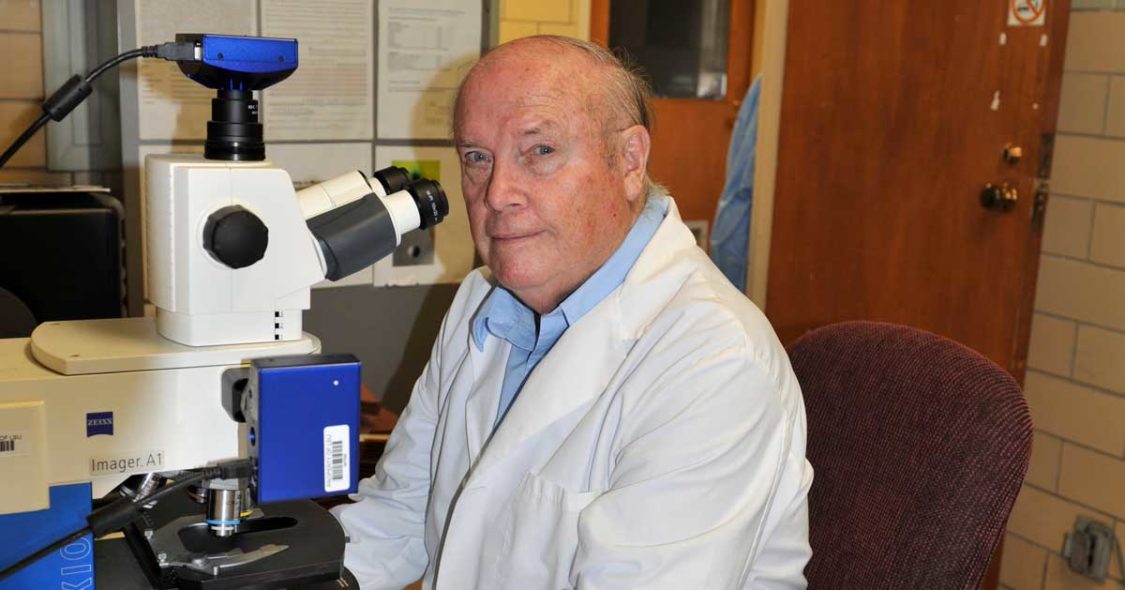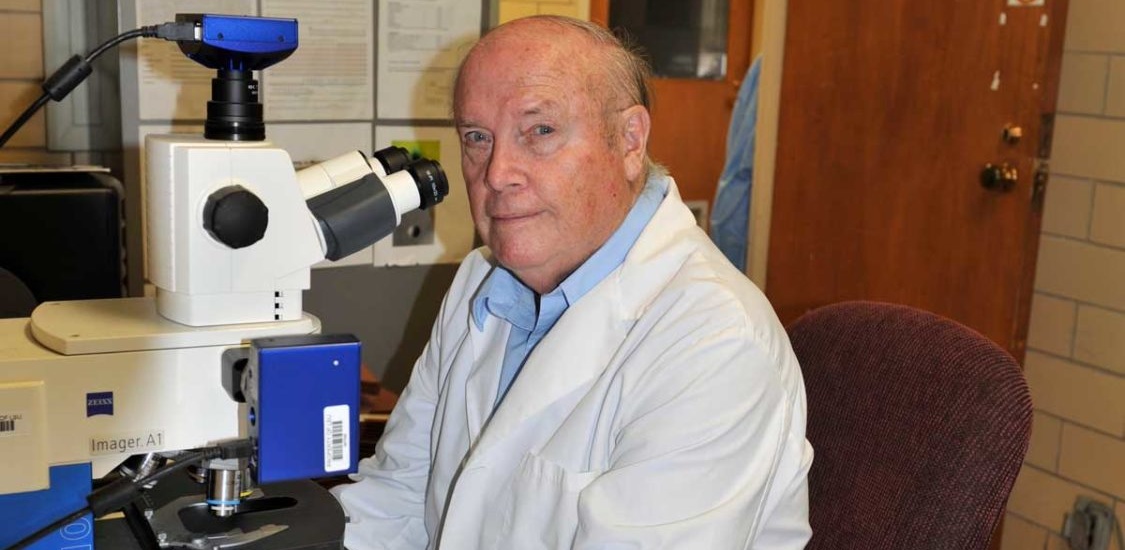It is possible to eradicate chronic wasting disease — at least on some levels — in white-tailed deer. Bacteria, not prions, are present in all transmissible spongiform encephalopathy diseases. And, perhaps most shocking, up to 15 percent of all Alzheimer’s disease deaths might be misclassified cases of Creutzfeld-Jakob disease. Those are three bold statements made recently by disease researcher Dr. Frank O. Bastian, and he is standing by them.
The view that chronic wasting disease is not caused by a prion but by a spiroplasma bacterium has disrupted the deer world in recent weeks, but that doesn’t mean minds are ready to change.
For decades, research into the prion theory — that TSE diseases are caused by a “misfolded protein” — has been heavily funded, but has shown little results in terms of a cure or even the mitigation of CWD.

Dr. Frank O. Bastian has worked as a clinical professor of neurosurgery and pathology at Louisiana State University (LSU).
Enter Dr. Bastian. The researcher most known for his work at the Louisiana State University Ag Center has been conducting research on a different track. He sees evidence that a bacterium is the culprit, and the prion is only a marker. In fact, he says the Spiroplasma bacteria is present in every case of a TSE disease, but the prion is not.
Dr. Bastian reportedly first found Spiroplasma in the brain of a Creutzfeld-Jakob Disease patient in an autopsy in 1979. He later demonstrated that Spiroplasma mirum strain SMCA (suckling mouse cataract agent) induces a microcystic spongiform encephalopathy in suckling rats that is similar to rat CJD. In 2007 he isolated Spiroplasma from scrapie and chronic wasting disease (a TSE affecting deer, elk and moose, abbreviated CWD), cultured them, and inoculated them into sheep and deer.
Dr. Bastian is a neuropathologist and has spent years researching the bacteria as infectious agents. Prion researchers have been quick to criticize his work, stating that it has not met the test of duplication, but that’s where his recent breakthrough has come. After years of research, Dr. Bastian states that he has been able to isolate the bacteria and has developed a culture in which the organism can be grown. If proven, this important advance sets the stage for rapid development of research on all forms of TSE diseases. The trouble is that currently tens of millions of dollars are funding prion research, and virtually nothing is spent on bacterial research.
Bacterium in Lab Findings
In an interview exclusive to Deer & Deer Hunting, I spoke with Dr. Bastian late last night and asked a number of questions. His answers all focus on the urgency that TSE diseases represent and the immediate need for research into the bacterial cause.
For starters, Dr. Bastian believes as many as 15 percent of Alzheimer’s cases — particularly those that develop in a matter of months or a couple of years — are really Creutzfeldt-Jakob disease, the human TSE variant. He said he believes that early screening of these people will show that some have a curable bacterial infection.
Dr. Bastian said he is also concerned about the safety and protection of the cattle industry, other livestock and zoo animals. He said that he also cares about white-tailed deer and other wildlife, and understands that the entire wild deer herd may be at stake.
I asked Dr. Bastian whether the same species of spiroplasma bacteria causes all TSE diseases. He answered that he thinks the answer is “probably, but not the same strain of the bacteria.” He also said he is confident they are immunologically different, but genome studies will eventually determine how different they are.
If the spiroplasma is the cause of CWD, Dr. Bastian said a vaccine could be developed to combat it, and that immunization would come through the introduction of antibodies.
“CWD could be eradicated in captive deer populations, just as other TSEs could be in livestock and in zoo populations,” he said. “Wild populations are another matter. Here, we will need wildlife biologists to develop delivery methods for both treatment and immunization. In CJD, we would not immunize everyone, but the members of a family of a CJD victim could be immunized. This could open the door to new research into ALS (Lou Gehrig’s disease) and some of the other neurodegenerative diseases.”
I asked about the hunter’s test kit that some reports say could be available in a couple of years. Dr. Bastian says it can definitely happen.
“Before field-dressing, a drop of blood on a test strip will be able to determine whether a harvested deer is infected or not, even in the early stage of the disease, and even if the deer appeared healthy,” he said.
Responding to His CWD Critics
I also asked Dr. Bastian what he says to those who have criticized his research for not being repeatable.
“Nobody has really tried,” he said. “Some who say they have did not strictly use the same methods.”
Oddly, this criticism of Dr. Bastian’s bacterial research is exactly what’s wrong with prion research. All infectious disease agents are normally isolated and grown, but prions have not been reproduced. Dr. Bastian said he attended one conference where a researcher presented a paper on replicating prions, then concluded by saying, “This is all conjecture.”
Read More: PRION RESEARCHERS SKEPTICAL OF BACTERIUM STUDIES
I also asked whether there are any state wildlife departments that view CWD as having a bacterial cause, and not a prion cause. He said none yet that he knows of, but scattered around the country are groups that are very interested in his research, including captive deer breeders in Texas, Louisiana and other states, the Unified Sportsmen of Pennsylvania, and many veterinarians he has spoken with.
Veterinarians have a strong background in infectious agents, and many don’t understand how prions can be an infectious agent. I asked why so many scientists persist in believing TSE diseases are caused by the prion, when prion research has failed to show how the prion acts as an infectious agent.
“That is because that’s where the research money goes,” he said. “Once a majority of scientists are invested in one direction, a dogma develops that is difficult to change. Real science, however, always challenges the accepted wisdom of the status quo. We are now able to cultivate the spiroplasma bacteria that is present in every case of TSE diseases. We need more labs involved, which will lead to more expertise being applied to the study. Once that happens, more funding will come; wildlife scientists will show more interest; more minds will change, and we will get some real action on CWD and related diseases.”
Bastian said that he has spent a significant amount of his own money on this research looking for answers, and is not interested in fame, fortune or any personal gain from finding a cure for TSEs. He simply wants more answers.
“More research is definitely needed,” he stated. “If someone else gets credit for these breakthroughs, that’s fine by me. I don’t care who gets the credit. I am not looking for personal credit.”

Dr. Frank O. Bastian
Dr. Bastian’s Biography
Specialization:
Dr. Bastian’s research centers around a lifetime of work searching for the causal agent of the transmissible spongiform encephalopathies (TSE). He has shown that a wall-less bacterium, spiroplasma, is consistently associated with the TSEs. Recently at LSU Agricultural Center, he and collaborators in the Dept. of Veterinary Science have developed a Ruminant Model of TSE that will be used to study pathogenic mechanisms involved in the spiroplasmosis models. In collaboration with Dr. Thune, a genomic study will be conducted on the putative organism, which should dramatically help understand the role of spiroplasma in TSE.
Research studies:
Bastian FO, Rabson AS, Yee CL, Tralka TS: “Herpes virus hominis: Isolation from human trigeminal ganglion.” Science l972;178:306-307.
Bastian FO, Rabson AS, Yee CL, Tralka TS. “Herpes virus varicellae: isolation from human dorsal root ganglia.” Archives of Pathology & Laboratory Medicine. 1974;97:331.
Bastian FO. “Spiroplasma-like inclusions in Creutzfeldt-Jakob disease.” Archives of Pathology & Laboratory Medicine. 1979;103:665-669.
Bastian FO, Hart MN, Cancila PA. “Additional evidence of spiroplasma in Creutzfeldt-Jakob disease.” Lancet 1980; 1:660.
FO, Rabson AS, Yee CL, Tralka TS. “Herpes virus hominis: isolation from human trigeminal ganglion” Science. 1972.
Bastian FO, Purnell DM, Tully JG. “Neuropathology of spiroplasma infection in the rat brain.” American Journal of Pathology. 1984;114:496-514.
Tully JG, Bastian FO, Rose DL. “Localization and persistence of spiroplasma in an experimental brain infection in suckling rats.” Microbiology. 1984;135:111-117.
Bastian FO, Jennings RA, Gardner WA. “Antiserum to scrapie-associated fibril protein cross-reacts with Spiroplasma mirum fibril protein.” Journal of Clinical Microbiology. 1987;25:2430-2431.
Bastian FO, Jennings RA, Huff C. “Neurotropic response of Spiroplasma mirum following peripheral inoculation in the rat.” Microbiology. 1987;138:651.
Bastian FO, Baliga BS, Pollock HM. “Evaluation of a modified Hthymidine uptake method for studying growth of spiroplasmas under varying conditions.”Journal of Clinical Microbiology. 1988;26:2124-2126.
Bastian FO, Jennings RA, Hoff CJ. “Effect of trimethoprim/sulphasoxazole and hyperbaric oxygen on experimental Spiroplasma mirum encephalitis.” Microbiology. 1989;140:151-158.
Bastian FO. “Review of theories on the nature of the transmissible agent.” In: Bastian FO, ed. Creutzfeldt-Jakob disease and other transmissible spongiform encephalopathies. St. Louis: Mosby/Year Book, 1991.
Bastian FO. “Bovine spongiform encephalopathy: relationship to human disease and nature of the agent.” ASM News 1993;59:235-240.
Brown P, Cervenakova, Goldfarb LG, Bishop K, Bastian FO, Kirkpatrick J, Piccardo P, Ghetti B, Gajdusek DC. Creutzfeldt-Jakob disease in a husband and wife. Neurology. 1998;50: 684-688.
Bastian FO, Foster JW. Spiroplasma sp. 16S rDNA om “Creutzfeldt-Jakob disease and scrapie as shown by PCR and DNA sequence analysis”. Journal of Neuropathology Exp Neurol 2001;60: 613-620.
Bastian FO, Dash S, Garry RF. “Linking chronic wasting disease to scrapie by comparison of Spiroplasma mirum ribosomal DNA sequences.” Exp Molecular Pathology. 2004;77: 49– 56
Bastian FO, McDermott ME, Perry AS, Carver LA, Dash S, Garry RF. “Safe method for isolation of prion protein and diagnosis of Creutzfeldt-Jakob disease.” Journal Virol Methodology. 2005;130: 133-139.
Bastian FO. “Spiroplasma as a candidate agent for the transmissible spongiform encephalopathies.” Journal of Neuropathology Exp Neurology. 2005;64:833-838.
Bastian, FO, Sanders, DE, Forbes, WA, Hagius, SD, Walker, JV, Henk, WG, Enright, FM, Elzer, PH. “Spiroplasma spp. from transmissible spongiform encephalopathy brains or ticks induce spongiform encephalopathy in ruminants.” Journal of Medical Microbiology. 2007; 56:1235-1242.
Education
Bachelor of Arts Degree, Biology, University of Saskatchewan, 1960
Doctorate (MD), University of Saskatchewan, 1964
Residency, Neuropathology, Duke University, 1968-72
Fellowship, Virology, National Institutes of Health, 1972
Career
1972 to 1979: Assistant Professor, Baylor College of Medicine, Houston.
1979 to 1982: Associate Professor of Pathology, University of Maryland, Baltimore.
1982 to 1992: Associate Professor of Pathology, University of South Alabama College of Medicine, Mobile.
1992 to 2001: Professor of Pathology, University of South Alabama College of Medicine, Mobile.
2002 to 2019: Professor of Pathology at Tulane University School of Medicine at New Orleans.
2005 to 2019: Professor, Dept of Veterinary Science, LSU Agricultural Center, Baton Rouge.
— — — — — —
Read more: Study: CJD Risk in Humans Almost Nonexistent in Endemic Area
Read more: 5 CWD Questions We All Must Answer
Read more: CWD Monkeys Were Fed Cannibal Diet
Read more: Pennsylvania Lawmaker Calls for Cure, Not Cull
Read more: Prion Researcher: Urine Bans are Illogical
Read more: Opinion: Michigan Hunters Are Being Lied To
Read more: There is No Uniform Approach in How States Fight CWD
Read more: Deer Might Spread CWD Through Water
Read more: Study Confirms Females Pass CWD to Their Fawns
Read more: Researchers Tackle CWD Questions
Read more: Ozoga: Does CWD Drive Whitetail Population Declines?
Read more: Iowa Supreme Court Rules Against CWD Quarantine
Read more: Opinion: Hunters – Stop the CWD Hysteria … Please
Read more: Man Arrested for Importing Deer with CWD

